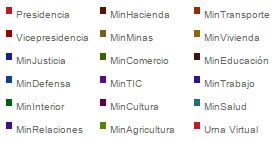What is the Carbon Calculator 2050?
The dilemma we are facing climate change is as old as humanity itself, only led to the tenth power. Generate welfare costs. So eat means less stored food, have resources such as electricity, transportation and food has very specific costs. These costs can be measured in money (how much to produce), natural resources (how many liters of water or hectares of forest are needed) or emission (how many tonnes of greenhouse gases are emitted to produce or use a good or service) .
The problem with the latter cost is that we issue is determining our future as a species: every degree you raise the temperature means losing 6 percent of wheat crops, an increase in sea level of up to five meters (endangering the existence of coastal populations) and the disappearance of glaciers that provide water to much of the world's cities.
To prevent global temperatures from rising more than 2 degrees Celsius by 2050, per capita emissions globally will come down to a maximum of 2 tons per person 7 tons per person per year.
Last week was presented to the 2050 Carbon Calculator, a tool that will allow us to take into account what cost us the choices we make in development. These decisions can be as basic as how transport favor as a society, where we grow our food and where our electricity comes from.
Who is behind it?
The United Nations Development Programme (UNDP) has been without doubt one of the main promoters of a green growth agenda in Colombia. Its resources, despite having a relatively low profile, have been an essential support in the development strategy of the Colombian low-carbon development. This program, under the leadership of the Ministry of Environment and Sustainable Development (MADS), coordinates all the state's actions to mitigate the emotions of greenhouse gases that cause climate change. What little is published it is that UNDP resources have come to finance a number of contractors who today sit in the MADS to coordinate the implementation of the strategy.
Another institution that has been key to this issue is the British Embassy in Colombia, which has even brought twice to Colombia to Nicholas Stern, an economist who has been one of the most effective communicators urgent message of climate change.
Both entities, with the support of MADS and ECDBC lasted more than a year developing a version of Carbon Calculator to Colombia. The team was formed by members of the environmental team of UNDP and the Department of Energy and Climate Change in the UK. The team, which we hope will soon outline, consists mostly of women, mostly under 30, with much technical assistance of British experts.
What is it good for?
For now the calculator is designed to be used by decision makers macro, particularly in the public sector. However, individuals can also use the input to make decisions or lay their positions on public policy. It never hurts to know how much it costs, in terms of survival, so we decided to do today.
Sustainable Week, mere ordinary people (not engineers or mathematicians) we sat down to use the calculator, and found out the following:
The sectors included are the most significant for Colombia: buildings, industry, transport, electricity (renewable and non-renewable), waste, forests, agriculture, forestry, transportation, fossil fuels and biofuels.
Calculations are made based on the IPCC scenarios like but according to his ambition: from minimal to extreme. For each sector explained why the level of ambition is concerned.
Apparently, the most effective tendency to have the greatest impact in the case of Colombia is the use of the land.
Transportation decisions are perhaps the most interesting individuals to leave just because of individual behavior.
It is very easy to use on the site and for those who want to play with the model, it is very easy to download the Excel and play with the numbers.




